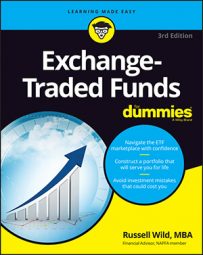Treasury bond ETFs come in short-term, intermediate-term, and long-term varieties, depending on the average maturity date of the bonds in the ETF’s portfolio. In general, the longer the term, the higher the interest rate but the greater the volatility.
Note that interest paid on Treasurys (yeah, that’s how they’re typically spelled) — including Treasury ETFs — is federally taxable but not taxed by the states.
Following are detailed descriptions of three popular iShares Treasury ETFs. You’re not likely to do much better than iShares in this particular category.
iShares Barclays 1–3 Year Treasury Bond Fund (SHY)
Indexed to: The Barclays Capital U.S. 1–3 Year Treasury Bond Index, an index tracking the short-term sector of the U.S. Treasury Bond Index. The fund uses a representative sampling — typically around 35 individual bond issues.
Expense ratio: 0.15 percent
Current yield: 0.25 percent
Average weighted maturity: 1.9 years
This ETF and others of its ilk (such as the Vanguard Short-Term Government Bond ETF [VGSH]) are fine for what they are. Sure, very short-term Treasurys are ultra-safe investments with little — almost no — volatility. And the yield may be better than you can get in your local savings bank. Maybe. With yields on short-term Treasurys so low, that may not be the case.
Keep in mind that every time you make a deposit or withdrawal, unless you hold VGSH at Vanguard, you’ll very likely pay a commission. You may do better keeping your short-term money in a three- to six-month CD or in an Internet bank like EmigrantDirect or Ally Bank. The latter two options generally pay just as much as SHY; they are FDIC insured (making them just as safe); and you won’t pay for each and every transaction.
iShares Barclays 7–10 Year Treasury Bond Fund (IEF)
Indexed to: The Barclays Capital U.S. 7–10 Year Treasury Bond Index, an index tracking the intermediate-term sector of the U.S. Treasury market. The fund uses a representative sampling — typically around 15 individual bond issues.
Expense ratio: 0.15 percent
Current yield: 2.58 percent
Average weighted maturity: 8.6 years
Expect modest returns and modest volatility. Of the three kinds of Treasurys, the intermediate-term bonds make the most sense for most people’s portfolios, and IEF is an excellent way to invest in them.
Vanguard’s Intermediate-Term Government Bond Index ETF (VGIT) would be another good option; it is a very similar fund with just about the same components and costs. Whatever your total allocation to fixed income, IEF (or VGIT) deserves an allotment of perhaps one-fifth to one-third of that amount.
iShares Barclays 20+ Year Treasury Bond Fund (TLT)
Indexed to: The Barclays Capital U.S. 20+ Year Treasury Bond Index, an index tracking the long-term sector of the U.S. Treasury market. The fund uses a representative sampling — typically around 15 individual bond issues.
Expense ratio: 0.15 percent
Current yield: 4.3 percent
Average weighted maturity: 28.1 years
Treasurys are perhaps the safest investment in the land, but not entirely risk-free. The size of our nation’s debt and deficit makes the hills of Pennsylvania look flat by comparison. Honestly, this issue is frightening and only recently has the U.S. electorate (thanks to a debt stalemate in Congress in 2011) seemed to take notice.
A short-term Treasury bill may be risk-free, but a 20+ year Treasury? Wave your flag all you like, but you take on some risk of principal loss here. And given the maturity of the bond, you’re certainly going to encounter a heck of a lot of volatility.

